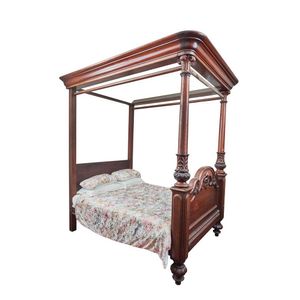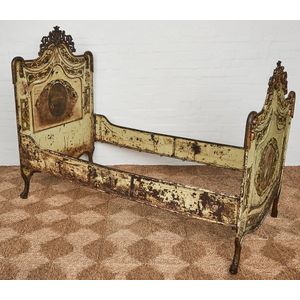
Impressive Australian Cedar Four-Poster Bed with Cast Iron Brackets
A large and very impressive carved cedar and rose-mahogany four-poster bed. Australian circa 1845. unusually supported by cast iron brackets with wood wheels to aid in mobility and ease of bed-making. Provenance: The Collection of Graham and Elizabeth…

Austrian painted metal parcel-gilt single bed, late 19th century
Austrian painted metal parcel-gilt single bed, late 19th century, pistachio coloured, surrmounted by central crowned figure flanked by two mermaids, above scrolls and tassels, with central medallion, height 150 cm, length 197 cm, depth 96 cm; 192 x 94 cm,…

Austrian 19th Century Painted Metal and Gilt Single Bed
Austrian painted metal and parcel-gilt single bed, late 19th century, dark rifle green, surrmounted by central crowned figure flanked by two mermaids, above scrolls and tassels, central medallion with gilt birds butterflies and foliage, height 153 cm,…

Tasmanian Colonial Blackwood Double Bed
Colonial double bed ends, blackwood and eucalypt, Tasmanian origin, early to mid 19th century, with later iron rails, 122 cm high, 132 cm wide

Tasmanian Convict Iron Bed, 19th Century
A convict folding iron bed, Tasmanian origin, 19th century, 190 cm long

Edwardian Huon Pine Double Bed with Cast Iron Rails
An Edwardian double bed in huon pine with, two panelled decoration, on head & foot, includes cast iron rails, height 136 cm, length 215 cm, depth 152 cm
 Loading more...
Loading more...